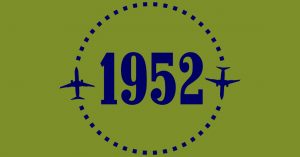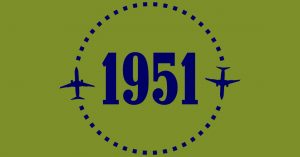Time flight: 1950
A journey around the media of 1950

 After finding my previous explorations of the 1960s, 1970s and 1980s so interesting, I want to do some more time travelling with television. I’ve a specific aim in mind this time, which will take me back a tad further. First though, I’ve been acclimatising myself by sampling some early 1950s. I’ve also been soaking up some wider entertainment from the period, occasionally visiting the pictures, a bookshop and a record store.
After finding my previous explorations of the 1960s, 1970s and 1980s so interesting, I want to do some more time travelling with television. I’ve a specific aim in mind this time, which will take me back a tad further. First though, I’ve been acclimatising myself by sampling some early 1950s. I’ve also been soaking up some wider entertainment from the period, occasionally visiting the pictures, a bookshop and a record store.
There will be few reading this who have not had television as a constant throughout their lives – certainly since childhood. I’ve found it fascinating to start getting my head around an era of broadcasting where television is a minority medium. One of the best summations I’ve heard was from writer and producer John Wyver; I was intrigued to hear him explain that “television is not the stable, domestic” thing it would become by the late 1950s, describing it as “an extension of radio”.
1950 is an appropriate time for me to begin this project. It’s the first full year of the BBC transmitting television to the Midlands, marking the start of television’s expansion beyond London. There were 126,567 combined TV and radio licences in 1949, which had more than doubled to 343,882 by 1950. This rate of increase would only continue. For now though, these are relatively small numbers; television’s audience is a lucky, middle class minority.
Radio broadcasts are being enjoyed regularly in far more homes – the radio-only licence reached its peak in 1950, numbering 11,567,227 – and the dominance of sound broadcasting would remain for several years. To reflect the continued importance of radio in people’s lives during these years, I’ve decided to include radio programmes in my schedule too, and you will notice that I’ve mixed them in with the television programmes.
Are you sitting comfortably? Then I’ll begin.
✹
Thursday 27 July
BBC Light Programme
The Adventures of P.C. 49 ‘The Case of the Black Diamonds’
 If exploring this era’s TV is like visiting a foreign country, looking into radio feels like being plonked on a passing asteroid heading for another galaxy, with only the vague memories of a junior encyclopaedia and some Professor Brian Cox documentaries. In situations like these, it’s very useful to be able to call for help to friends at Transdiffusion HQ. For instance, why is it called the ‘Light Programme’ when it’s not actually a programme as I understand the term and is in fact a radio station? If your radio knowledge is similarly patchy, start here.
If exploring this era’s TV is like visiting a foreign country, looking into radio feels like being plonked on a passing asteroid heading for another galaxy, with only the vague memories of a junior encyclopaedia and some Professor Brian Cox documentaries. In situations like these, it’s very useful to be able to call for help to friends at Transdiffusion HQ. For instance, why is it called the ‘Light Programme’ when it’s not actually a programme as I understand the term and is in fact a radio station? If your radio knowledge is similarly patchy, start here.
With albums, podcasts and audiobooks to choose from, I am usually overwhelmed with audio choice, yet I’ve never been much of a radio listener in the modern day – actually, that’s an understatement; I haven’t regularly listened to current radio in over a decade. I have listened to some radio series from around this period though. Most are from a few years later, but I have ventured earlier with a few 1940s episodes of It’s That Man Again – often known simply as ITMA. All this radio I’ve been drawn to has been comedy, although my experience with the far-more-recent Big Finish audio plays meant I was curious to hear some radio drama.
The Adventures of P.C. 49 has been running since 1947 and a film version (with a different cast) was released in 1949. Its sequel, A Case for PC 49 will appear next year and this time some of the radio cast will be involved.
This show’s title had given me the impression that the eponymous P.C. 49 would be front and centre, yet he doesn’t appear until over halfway through and most of the episode sticks with the criminals. We follow them as they plan, carry out and then attempt to get away with a train robbery.
I really enjoyed the exciting action, particularly during the theft itself, which involves one of the thieves – Tom, a train employee – clambering across the train’s roof and dangling down to get across the compartments, unseen. He nervously panics when the guard he had planned to cosh sees his face, and Tom decides he has to do him in.
I hadn’t expected to know any of the main cast, so it was nice to have familiar voices among the guests with John Laurie and Gordon Jackson. Elsewhere, Mary MacKenzie plays Janet, a young woman who plans the whole venture. Her posh English accent stood out next to the other two’s Scottish ones and, combined with her harsh roguishness, she conjured up an image of the deceptive ladies I’ve come across in The Saint books.
✹
Saturday 12 October
BBCtv
The Debate Continues
WATCH ON BBC IPLAYER
 My first television programme of the decade was a documentary on the reconstruction of the House of Commons, which had suffered bomb damage during the war. I found it informative as though I knew the Commons had been damaged, I hadn’t realised it was so extensive that Parliament had had to move out.
My first television programme of the decade was a documentary on the reconstruction of the House of Commons, which had suffered bomb damage during the war. I found it informative as though I knew the Commons had been damaged, I hadn’t realised it was so extensive that Parliament had had to move out.
There was some talk on the war – presumably in case a few viewers had failed to notice the Luftwaffe – then we watched trees being felled and skilled craftsman recreating various aspects of the previous version of the Commons. I particularly enjoyed seeing the wooden carvings take shape – today someone would upload it to social media with #satisfying. I could gradually start to match up sections with the House of Commons I’m familiar with in the present day. It was slightly different because I’ve never seen the interior in black and white, then I remembered that 1950s viewers were unlikely to have seen much, if any, of the House of Commons before. This must have been all the more fascinating for them.
With so little programming surviving in a complete form, there must have been good reason for The Debate Continues to have done so. One reason is that it wasn’t made on expensive-and-temptingly-reusable videotape, but by the BBC Film Unit. Created in 1948, the Film Unit was soon separated from Outside Broadcasts and the majority of its output consisted of the BBC’s twice-weekly newsreels, as well as travelogues and documentaries. The Debate Continues is also clearly capturing an historical moment with speeches from Prime Minister Clement Attlee and Leader of the Opposition Winston Churchill.
However, for me the more exciting appearances were those of the Royal Family. I’m used to seeing Queen Elizabeth on telly, so I tend to take a glance at her hat on the news and that’s about it. But I’d almost forgotten I’d time travelled – when the royals arrived for the reopening ceremony, it was the King who stepped out of the leading car with his wife, the (other) Queen, whilst Princesses Elizabeth and Margaret followed in a second car. I associate King George VI with radio and cinema newsreels and was taken aback by the realisation that people could actually watch him in their own homes.
I was fascinated by the explanation of procedures. The events we watch are in Westminster Hall but we are told that the royals had been to see the new House of Commons chamber the day before; the significance of this is underlined when the narrator (one of a couple of unnamed voices) tells us it’s the first time a king has set foot in there since Charles I. George VI’s visit seems to have gone down better and didn’t impinge on Parliament’s right to exclude the monarch because the new chamber hadn’t actually been formally occupied yet.
Several speeches are made. It sounds ceremonially grand because it’s so grovelling towards the King – there is an emphasis on His Majesty allowing the people to use his Palace of Westminster. In the present day, there is not such widespread and unequivocal respect for the Royal Family, and I think many people’s reactions would be, “His palace? Our taxes have paid for it.”
✹
Monday 30 October
BBC Light Programme
Paul Temple and the Vandyke Affair ‘The Sitter In’
I am vaguely aware that there was a Paul Temple television series, but I knew nothing about that or the radio version. From this episode I gathered that Paul is some sort of private detective. A child has gone missing and, him having already been contacted by the mother, Mrs Gladstone, the police also turn up asking for Paul’s involvement. It’s clear Paul knows the officers but it’s not apparent why they are asking for his help – they’re stumped yet we’re not informed why Paul should do any better.
I was expecting the kind of excitement and thrills I’d had with The Adventures of P.C. 49, but Paul Temple was more about the intrigue slowly unfolding itself. There are minimal sound effects and everything is built around conversations, with numerous interviews as Paul and his wife start speaking to everyone involved.
While Mrs Gladstone, a widow, was out for the evening, her 18-month-old little girl was being looked after at home by Miss Millicent, an “elderly spinster” and the ‘sitter in’ of the title, who also disappeared at the same time.
Miss Millicent lives with Miss ‘Queenie’ Edwards and I’m calling it that they’re a couple. A friend of Mrs Gladstone says that when he told Queenie of Miss Millicent’s disappearance, “She seemed awfully upset”. Despite the “elderly spinster” badge, Miss Millicent is also described as an “old girl” and based on previous experiences, I’m inclined to believe she may only be around 50. With Queenie more specifically described as “about 30”, they have a large age gap, yet we’re still told that Queenie is “a sort of paying guest” and “they’ve been together for years”.
Although I enjoyed the episode and feel tempted back by the cliffhanger, I’m a tad sceptical about the serial’s ability to hold me until the end – I’m used to audio plays that are under two hours in total and, at eight episodes, I feel this Paul Temple may be too long for such a slow-moving drama to keep my attention.
✹
The Pictures
 In 1950 there were 4,583 cinemas across the country and UK admissions stood at almost 1.4 billion. For a comparison to today, by 2020 the UK had 843 cinemas (interestingly, the total number of screens for 2020 was 4,596 – perhaps due to the fact that almost half of all UK cinemas are now multiplexes, with 5 or more screens) and 2019’s admissions had reached 176 million – and this is the industry following a revival.
In 1950 there were 4,583 cinemas across the country and UK admissions stood at almost 1.4 billion. For a comparison to today, by 2020 the UK had 843 cinemas (interestingly, the total number of screens for 2020 was 4,596 – perhaps due to the fact that almost half of all UK cinemas are now multiplexes, with 5 or more screens) and 2019’s admissions had reached 176 million – and this is the industry following a revival.
Impressive as 1950’s statistics are, I wonder whether many people realised that admissions had already passed the start of a steep decline. Nonetheless, at the start of the decade television is a relatively minor affair for most people. If we go by the UK’s population, cinema attendances work out at more than twice a month per person. Surveys showed that more than half of admissions were of people going twice a week or more.
I’m far from a film buff – I’ve always invested too much time and interest in television to fit films in, even though I’d like to see more. It might seem easy and obvious to explore cinema through the top films for each year, but I’ve seen several of them and I can guarantee you probably have too – you’ll certainly have heard of them. Plus, I’m not sure these films are necessarily representative – they’re exceptional, and so also potentially the exception in any given year.
Instead, I’m mainly going to visit the alternative picture palace of Talking Pictures TV. Their admission prices are very reasonable and, hopefully, it should provide me with a varied choice of film treats.
Cheaper By the Dozen
Released: 31 March
Certificate: U
I have not seen the 2003 film of the same name, but from its synopsis I think it is quite different and doesn’t sound like a strict remake of this one. This can only be for the best. While the 1950 version of Cheaper By the Dozen was billed as a comedy, I found few laughs and it was barely entertaining.
At the start of the film, the family’s father, Frank Gilbert, whistles and then times how long it takes the kids to appear. They then jump into line in age order for him to inspect how clean their hands are. One lad in a baseball uniform is admonished for his dirty palms, which seems bizarre because he is a young boy who has been playing outdoors and has literally just been yoinked inside. Although the film is set in the 1920s, I found it odd that this whole scenario is presented seriously and acceptable – it resembles a similar line-up in The Sound of Music, but the father there is depicted as harshly authoritarian.
Much of what I saw seemed highly twee and stereotypically ‘perfect’ American family at times, with umpteen cries of “Oh, gee!” The children also refer to their parents with “Ma’am” and “Sir” at times, which stood out, even though it is something I’ve come across before.
I think my biggest issue is that the film doesn’t have one overarching plot and is simply a series of disconnected scenarios bolted together.
✹
The Record Store
 When I previously visited the 1960s, I started tuning into the Singles Chart each year. It wasn’t often to my taste in the earlier years, but that in itself proved educational – the music I’d most associated with the decade wasn’t necessarily what I found in one week’s Top 10 or 20.
When I previously visited the 1960s, I started tuning into the Singles Chart each year. It wasn’t often to my taste in the earlier years, but that in itself proved educational – the music I’d most associated with the decade wasn’t necessarily what I found in one week’s Top 10 or 20.
I’ve always been more of an album person, so thought I might travel through the 1950s with those instead… except the UK didn’t have an album chart for much of the decade. Back to singles? Well, there wasn’t a singles chart until 1952 either.
I did have another option for 1950 though: Radio Luxembourg was among the few commercial radio stations whose airwaves could reach British ears, and they broadcast a sheet music Top 20. I decided to listen to the year’s number ones, and I’ll see how this arrangement goes until we get a chart based on record sales.
You’re Breaking My Heart
Ink Spots
★★★★☆ HIT
This reminded me of a 1930s’ crooner number and I’m partial to a bit of Al Bowlly, so enjoyed it.
Hop Skotch Polka
Billy Whitlock
★☆☆☆☆ MISS
Instrumental. I wanted someone to please make all the bells to stop.
The Harry Lime Theme
Anton Kara
★★★★☆ HIT
This piece from 1949’s The Third Man features a lovely bit of acoustic guitar.
Dear Heart and Gentle People
Dinah Shore
★★★★☆ HIT
Nice and jolly, but the word ‘wholesome’ was what mainly came to mind.
Music! Music! Music!
Teresa Brewer
★☆☆☆☆ MISS
The lyrics in this repeatedly refer to the “old nickelodeon” and by the end I was still unsure what that was. A jukebox? Google tells me yes but also a cinema. It had previously just been a TV channel to me and I’d assumed it was a nonsense word.
(If I Knew You Were Comin’) I’d’ve Baked A Cake
Eve Young and the Homesteaders
★★★☆☆ HIT
First song I was familiar with, though possibly by a different artist. This was cheesy and felt suitable for a children’s party, while also having a nice guitar lead.
My Foolish Heart
Billy Erkstine
★★½☆☆
I’m on the fence with this one. Billy has a very deep voice, but I wasn’t sure if I really found this performance that impressive.
Bewitched (Bothered and Bewildered)
Doris Day
★☆☆☆☆ MISS
A slow, quiet song that needs a more stunning singing voice to be the star of it.
Silver Dollar (Roll, Roll, Roll)
Eve Young and the Homesteaders
★★☆☆☆ MISS
Irritating.
Goodnight Irene
Frank Sinatra
★★★☆☆ HIT
It isn’t the big band style I know Frank for, but I still found it enjoyable.
Rudolph the Red-Nosed Reindeer
Gene Autry
★★★☆☆ HIT
I’m used to hearing the Bing Crosby version and if I hadn’t, I would probably be happy enough with Gene’s version. Yet it’s clear why one has gained more popularity; Gene’s Christmas number has an instrumental section while, even without that, Bing’s version is much faster and more upbeat.
About the author
H E Cooper is a writer on historical and cult television and pop culture



It’s quite fascinating seeing you go so far back that it’s even before my time!
I must confess to being a bit of a fan of Paul Temple, though I have no memory of hearing any of the radio series before around twenty years ago. I think it does grow on you, although Temple himself can be a bit smug at times, which is hardly endearing.
Anton Karas’s theme to The Third Man was something I heard a long time before I’d seen the film. We may have had a record of it, I’m not sure, but I do remember my mum having the sheet music for The Harry Lime Theme, but arranged for the piano. It’s not an acoustic guitar, by the way, Anton Karas was a player of the zither. If you hang around in the 1950s for long enough you may encounter the Australian Shirley Abicair. She was another exponent of that instrument – I’m not sure what it was about the late 40s or early 50s that made them suddenly popular.